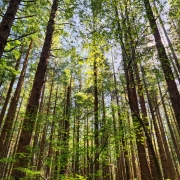Bears in Tofino - Living with the wild
November 1, 2005 | Marcia Moncour
Clayoquot Sound is a special place to live and visit because we are exposed to the elements of the wild west coast. Rugged coastlines, giant trees of the coastal temperate rainforest and diverse wildlife are just steps from our front doors. Such closeness to the natural world challenges us to live with greater care for the environment and to follow certain guidelines hopefully ensuring that this place remains intact for future generations.
One animal that has been getting a lot of attention lately and whose behaviour we need to adapt to is the Black Bear. The black bears (or chams in Nuu-Chah-Nulth) living here are a distinct subspecies unique to Vancouver Island. A high density of these animals live in Clayoquot and Barkley Sounds. Adult females weigh between 60 and 70 kilograms while adult males can weigh up to 220 kilograms. Females become sexually mature at 3 to 4 years and produce 1-4 cubs every few years. It is thought that black bears can live up to 30 years in the wild.
Adult male black bears have a large home range of approximately 150 km2 while adult female bears usually occupy a range of only about 13 km2. Male territories generally overlap with several female bear home ranges. Typically the territories include seasonal feeding areas connected by trails through forested areas and shorelines like the mudflats.
Bears have poor eyesight but an exceptional sense of smell (about 35% better than humans). They are said to be able to detect a food source several kilometers away! In the fall black bears are extremely food driven and may increase their weight by 20-30%. While plentiful natural food sources such as plants, insects and meat are available year round for local bears, they might be right next to tempting non-natural food sources. Being curious and opportunistic, bears learn quickly to take advantage of unsecured garbage and food in residential and business areas as well as in campgrounds.
In our community there is no line separating the wilderness and us. As a bear acquires a taste for human foods it begins lose its fear of people and will take more chances to find ‘food rewards’. It may then put public safety at risk by getting too close to people. If this happens it is the bear that pays the ultimate price with its life. Regrettably in late September a large male black bear was destroyed as a result of repeatedly getting into residential garbage near Chesterman beach. Sources say that at present we have at least 2 more black bears in the Tofino area exploiting unsecured garbage sources, sometimes over and over at the same places. It cannot be stressed enough that ‘problem’ bears are not born, but are created.
Hard working volunteers from the Ucluelet and Tofino Bear Aware Committees are making strides to help educate the public about ways that they can secure their properties and decrease the conflict between bears and humans. They are willing to help anyone with their questions and challenges about how to become ‘bear smart’. To conserve this unique and beautiful species we all need to do our parts.
Assess your own situation:
Do you have black bears on your property every year?
Are there animal tracks on your property: bear trails, scat, mark trees etc.
Have they gotten into anything in the past? Bears have good memories.



